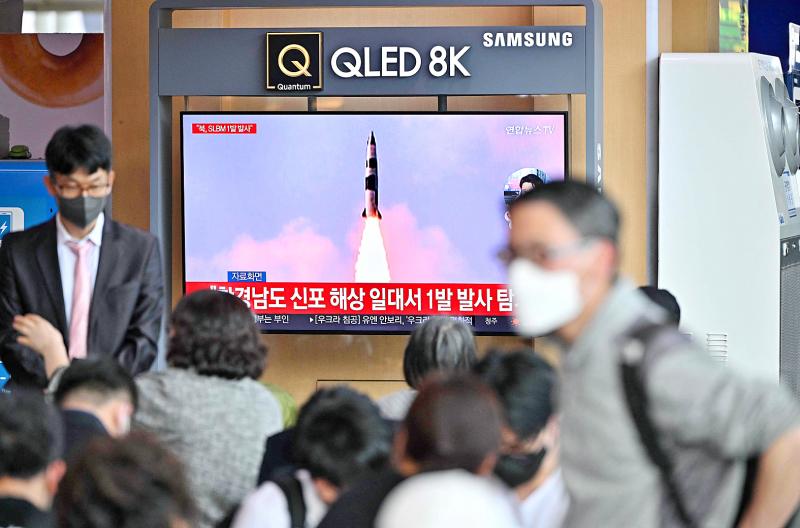North Korea might conduct a nuclear test between South Korean president-elect Yoon Suk-yeol’s inauguration on Tuesday and US President Joe Biden’s visit to Seoul later this month, South Korean National Intelligence Service Director Park Jie-won said yesterday.
If North Korea miniaturizes and lightens its nuclear warheads, short-range missiles can also be equipped with nuclear warheads, and the potential nuclear test is being viewed as very important because it could threaten South Korea and Japan, Park told Yonhap news agency in a telephone call.
His remarks came after the North yesterday fired a suspected ballistic missile designed to be launched from a submarine, South Korea’s military said, apparently continuing a provocative streak in weapons demonstrations that might culminate with a nuclear test in the coming weeks or months.

Photo: AFP
South Korea’s Joint Chiefs of Staff said the launch occurred from waters near the eastern port city of Sinpo, where North Korea has a major shipyard building submarines, but it did not immediately say how far the missile flew.
It also was not clear whether the launch would have involved an actual submarine or an underwater test platform.
The Japanese Ministry of Defense also confirmed the launch, but it did not immediately release flight details.
The launch was apparently North Korea’s first demonstration of a submarine-fired ballistic system since October last year, when it test-launched a new short-range missile from the 8.24 Yongung — its only known submarine capable of firing a missile — in what was its first underwater test launch since 2019.
The launch came three days after the South Korean and Japanese militaries detected the North firing a suspected ballistic missile from near its capital, Pyongyang, on Wednesday, and three days before the inauguration of Yoon, who has vowed to take a tougher approach over the North’s nuclear ambitions.
The latest launch was likely North Korea’s 15th round of missile firings this year, including its first test of an intercontinental ballistic missile (ICBM) since 2017 that demonstrated potential range to reach the entirety of the US mainland.
Experts say the unusually fast pace in testing activity underscores a brinkmanship aimed at forcing the US to accept the idea of the North as a nuclear power and remove crippling sanctions.
There are also signs that North Korea is restoring tunnels at a nuclear testing ground, where it had conducted its sixth and last nuclear test in September 2017, in possible preparations for another explosive test.
North Korean leader Kim Jong-un has punctuated his missile tests with statements warning that the North could proactively use its nuclear weapons if threatened or provoked, which experts say possibly portends an escalatory nuclear doctrine that would create greater concerns for South Korea and Japan.
Kim made one of those statements during a military parade in Pyongyang on Monday last week where he rolled out his ICBMs and what appeared to be a new type of missile designed to be fired from submarines.

Asian perspectives of the US have shifted from a country once perceived as a force of “moral legitimacy” to something akin to “a landlord seeking rent,” Singaporean Minister for Defence Ng Eng Hen (黃永宏) said on the sidelines of an international security meeting. Ng said in a round-table discussion at the Munich Security Conference in Germany that assumptions undertaken in the years after the end of World War II have fundamentally changed. One example is that from the time of former US president John F. Kennedy’s inaugural address more than 60 years ago, the image of the US was of a country

BLIND COST CUTTING: A DOGE push to lay off 2,000 energy department workers resulted in hundreds of staff at a nuclear security agency being fired — then ‘unfired’ US President Donald Trump’s administration has halted the firings of hundreds of federal employees who were tasked with working on the nation’s nuclear weapons programs, in an about-face that has left workers confused and experts cautioning that the Department of Government Efficiency’s (DOGE’s) blind cost cutting would put communities at risk. Three US officials who spoke to The Associated Press said up to 350 employees at the National Nuclear Security Administration (NNSA) were abruptly laid off late on Thursday, with some losing access to e-mail before they’d learned they were fired, only to try to enter their offices on Friday morning

Cook Islands officials yesterday said they had discussed seabed minerals research with China as the small Pacific island mulls deep-sea mining of its waters. The self-governing country of 17,000 people — a former colony of close partner New Zealand — has licensed three companies to explore the seabed for nodules rich in metals such as nickel and cobalt, which are used in electric vehicle (EV) batteries. Despite issuing the five-year exploration licenses in 2022, the Cook Islands government said it would not decide whether to harvest the potato-sized nodules until it has assessed environmental and other impacts. Cook Islands Prime Minister Mark Brown

STEADFAST DART: The six-week exercise, which involves about 10,000 troops from nine nations, focuses on rapid deployment scenarios and multidomain operations NATO is testing its ability to rapidly deploy across eastern Europe — without direct US assistance — as Washington shifts its approach toward European defense and the war in Ukraine. The six-week Steadfast Dart 2025 exercises across Bulgaria, Romania and Greece are taking place as Russia’s invasion of Ukraine approaches the three-year mark. They involve about 10,000 troops from nine nations and represent the largest NATO operation planned this year. The US absence from the exercises comes as European nations scramble to build greater military self-sufficiency over their concerns about the commitment of US President Donald Trump’s administration to common defense and